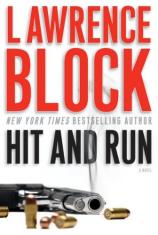Excerpt
Excerpt
Hit and Run

Keller drew his pair of tongs from his breast pocket and carefully lifted a stamp from its glassine envelope. It was one of Norway's endless Posthorn series, worth less than a dollar, but curiously elusive, and missing from his collection. He examined it closely, held it to the light to make sure the paper hadn't thinned where a hinge had once secured it to an album page, and returned it to the envelope, setting it aside for purchase.
The dealer, a tall and gaunt gentleman whose face was frozen on one side by what he had explained was Bell's palsy, gave a one-side-of-the-face chuckle. "One thing I like to see," he said, "is a man who carries his own tongs with him. Minute I see that, I know I've got a serious collector in my shop."
Keller, who sometimes had his tongs with him and sometimes didn't, felt it was more a question of memory than seriousness. When he traveled, he always brought along his copy of the Scott catalog, a large 1,100-page volume that listed and illustrated the stamps of the world from the very first issue (Great Britain's Penny Black, 1840) through the initial century of philately and, in the case of the British Empire, including the last of the George VI issues in 1952. These were the stamps Keller collected, and he used the catalog not only for its information but as a checklist, deliberately circling each stamp's number in red when he added it to his collection.
The catalog always traveled with him, because there was no way he could shop for stamps without having it at hand. The tongs were useful, but not indispensable; he could always borrow a pair from whoever had stamps to sell him. So it was easy to forget to pack tongs, and you couldn't just tuck a pair in your pocket at the last minute, or slip them in your carry-on. Not if you were going to get on an airplane, because some clown at Security would confiscate them. Imagine a terrorist with a pair of stamp tongs. Why, he could grab the flight attendant and threaten to pluck her eyebrows . . .
It was surprising he'd brought the tongs this time, because he'd almost decided against packing the catalog. He'd worked for this particular client once before, on a job that took him to Albuquerque, and he'd never even had time to unpack. In an uncharacteristic excess of caution, he'd booked three different motel rooms, checked into each of them in turn, then wound up rushing the job on an impulse and flying back to New York the same day without sleeping in any of them. If this job went as quickly and smoothly he wouldn't have time to buy stamps, and who even knew if there were any dealers in Des Moines?
Years ago, when Keller's boyhood stamp collection rarely set him back more than a dollar or two a week, there would have been plenty of dealers in Des Moines, as there were just about everywhere. The hobby was as strong as ever these days, but the street-level retail stamp shop was on the endangered species list, and conservation was unlikely to save it. The business nowadays was all online or mail order, and the few dealers who still operated stores did so more to attract potential sellers than buyers. People with no knowledge of or interest in stamps would pass their shop every day, and when Uncle Fred died and there was a collection to sell, they'd know where to bring it.
This dealer, James McCue by name, had his store occupying the ground-floor front of his home off Douglas Avenue in Urbandale, a suburb whose name struck Keller as oxymoronic. An urban dale? It seemed neither urban nor a dale to Keller, but he figured it was probably a nice enough place to live. McCue's house was around seventy years old, a frame structure with a bay window and an upstairs porch. The dealer sat at a computer, where Keller figured he probably did the greater portion of his business, and a radio played elevator music at low volume. It was a peaceful room, its manageable clutter somehow comforting, and Keller picked through the rest of the Norway issues and found a couple more he could use.
"How about Sweden?" McCue suggested. "I got some real nice Sweden."
"I'm strong on Sweden," Keller said. "At this point the only ones I need are the ones I can't afford."
"I know what that's like. How about numbers one to five?"
"Surprisingly enough, I don't have them. But then I don't have the three skilling orange, either." That stamp, cataloged as number 1a, was an error of color, orange instead of blue green, and was presumably unique; a specimen had changed hands a few years ago for three million dollars. Or maybe it was euros, Keller couldn't remember.
"Haven't got that fellow," McCue said, "but I've got one through five, and the price is right." And, when Keller raised his eyebrows, he added, "The official reprints. Mint, decent centering, and lightly hinged. Book says they're worth $375 apiece. Want to have a look?"
He didn't wait for an answer but sorted through a file box and came up with a stock card holding the five stamps behind a protective sheet of clear plastic.
"Take your time, look 'em over carefully. Nice, aren't they?"
"Very nice."
"You could fill those blank spaces with these and never need to apologize for them."
And if he ever did acquire the originals, which seemed unlikely, the set of reprints would still deserve a place in his collection. He asked the price.
"Well, I wanted seven-fifty for the set, but I guess I'll take six hundred. Save me the trouble of shipping 'em."
"If it was five," Keller said, "I wouldn't have to think about it."




